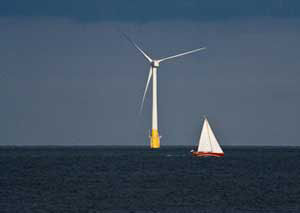Cape Wind, the proposed 24-square-mile wind farm off Cape Cod, just can’t catch a break. Fiercely opposed by the late Sen. Ted Kennedy and his family, who didn’t want rows of spinning turbines sullying their view of Nantucket Sound (they claimed the turbines would cause environmental problems), and getting no help from an otherwise green-tilting Sen. John Kerry (D-Mass.), the alternative energy project now has a new opponent: the Mashpee and Wampanoag American Indian tribes.
Situated on Martha’s Vineyard, the two tribes say the 130 turbines would disrupt their sunrise greeting ritual, which requires a clear view of the horizon, and disrupt ancestral burial grounds. In response to the tribes’ claims, the National Register for Historic Places announced it is considering the Cape Wind location for listing on its register, potentially ruling it out as a wind farm location. While it doesn’t outright kill the project, the National Register’s announcement could force developers to relocate it elsewhere.
The decision struck some as an unprecedented move, the New York Times reports:
Others said the finding was surprising because Nantucket Sound, which encompasses more than 500 square miles, is by far the largest body of water ever found eligible for listing on the national historic register. Other eligible bodies of water have included Walden Pond in Massachusetts, which covers about 60 acres, and Zuni Salt Lake in New Mexico, which is about 6,500 feet across, said Jeffrey Olson, a spokesman for the park service.
“The decision is without precedent in terms of implicating many square miles of what is, legally speaking, the high seas,” said Ian A. Bowles, the Massachusetts secretary of energy and environmental affairs. “But as a procedural matter, it’s a good thing a decision was reached, and the secretary is getting personally involved to get it over the finish line.”
Now, Cape Wind isn’t dead yet. Interior Secretary Ken Salazar told the tribes and Cape Wind’s developer they had until March 1 to reach a compromise, and even if they don’t, Salazar himself could still make the final call himself. That said, it’d be quite a surprise to see Salazar go against the powerful Kennedy family, the two tribes, and rest of Cape Wind’s fervent opponents.
















